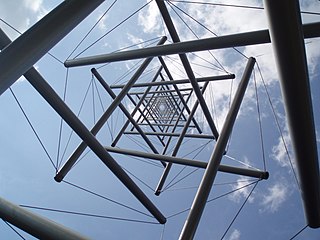
Helene Kröller-Müller was a German art collector. She was one of the first European women to put together a major art collection. She is credited with being one of the first collectors to recognise the genius of Vincent van Gogh. Her entire collection was eventually sold to the Dutch government, along with her and her husband, Anton Kröller's, large forested country estate. Today it is the Kröller-Müller Museum and sculpture garden and Hoge Veluwe National Park, one of the largest national parks in the Netherlands.

Outsider art is art made by self-taught individuals who are untrained and untutored in the traditional arts with typically little or no contact with the conventions of the art worlds.

Jean Philippe Arthur Dubuffet was a French painter and sculptor of the Ecole de Paris. His idealistic approach to aesthetics embraced so-called "low art" and eschewed traditional standards of beauty in favor of what he believed to be a more authentic and humanistic approach to image-making. He is perhaps best known for founding the art movement art brut, and for the collection of works—Collection de l'art brut—that this movement spawned. Dubuffet enjoyed a prolific art career, both in France and in America, and was featured in many exhibitions throughout his lifetime.

Niki de Saint Phalle was a French-American sculptor, painter, filmmaker, and author of colorful hand-illustrated books. Widely noted as one of the few female monumental sculptors, Saint Phalle was also known for her social commitment and work.

Kenneth Duane Snelson was an American contemporary sculptor and photographer. His sculptural works, exemplified by Needle Tower, are composed of flexible and rigid components arranged according to the idea of 'tensegrity'. Snelson preferred the descriptive term floating compression.

The Kröller-Müller Museum is a national art museum and sculpture garden, located in the Hoge Veluwe National Park in Otterlo in the Netherlands. The museum, founded by art collector Helene Kröller-Müller within the extensive grounds of her and her husband's former estate, opened in 1938. It has the second-largest collection of paintings by Vincent van Gogh, after the Van Gogh Museum. The museum had 380,000 visitors in 2015.

The Beyeler Foundation or Fondation Beyeler, with its museum in Riehen, near Basel (Switzerland), owns and oversees the art collection of Hildy and Ernst Beyeler, which features modern and traditional art. The Beyeler Foundation museum includes a space for special exhibitions staged to complement the permanent collection. In 2006, approximately 340,000 persons visited the museum. The number of visitors in 2016 was 332,000. The Beyeler Foundation is the most visited museum of art in all of Switzerland. The museum is properly funded, and it receives annual grants from the cantons of Basel City and Basel County and the commune of Riehen. Major partners of the Foundation are Bayer AG, Novartis and Swiss bank UBS.
Eugène Dodeigne was a French sculptor living and working at Bondues (Nord-Pas-de-Calais).

The Great Double is a bronze sculpture by the Argentine artist Alicia Penalba (1913-1982). One statue named Le Grand Double (1962-1964) is on display in the sculpture garden of the Dutch Kröller-Müller Museum. Another (1972) is on display outside the MGIC building in Milwaukee, Wisconsin.

Argo is a public artwork by Russian-American artist Alexander Liberman located on the south lawn of the Milwaukee Art Museum, which is in Milwaukee, Wisconsin, U.S.. The artwork was made in 1974 from steel cylinders painted with a reflective white epoxy finish. It measures 15 feet (4.6 m) high by 31 feet (9.4 m) wide.

Alliance is a 25-metre-high (82 ft) sculpture in the centre of Cardiff, Wales, created by Paris installation artist Jean-Bernard Metais. It consists of a large, partly enamelled, stainless steel arrow, and a hoop that glows in the dark. It was financed by the St David’s shopping centre as part of a £1.5m public art scheme in the city centre, and was unveiled on 3 December 2009.

LOVE is an artwork by American pop artist Robert Indiana (1928–2018), located at the Indianapolis Museum of Art at Newfields in Indianapolis, Indiana, United States. It was created in 1970 as the first sculptural form of the artist's 1965 LOVE painting and has been on continuous exhibition at the Indianapolis Museum of Art since it was acquired in 1975.

Modern sculpture is generally considered to have begun with the work of Auguste Rodin, who is seen as the progenitor of modern sculpture. While Rodin did not set out to rebel against the past, he created a new way of building his works. He "dissolved the hard outline of contemporary Neo-Greek academicism, and thereby created a vital synthesis of opacity and transparency, volume and void". Along with a few other artists in the late 19th century who experimented with new artistic visions in sculpture like Edgar Degas and Paul Gauguin, Rodin invented a radical new approach in the creation of sculpture. Modern sculpture, along with all modern art, "arose as part of Western society's attempt to come to terms with the urban, industrial and secular society that emerged during the nineteenth century".

Alicia Penalba was an Argentine sculptor, tapestry designer, and weaver.

Large Arch is an outdoor sculpture by British sculptor Henry Moore. It was installed in 1971 and is located in the outdoor plaza of the Cleo Rogers Memorial Library in Columbus, Indiana. Xenia and J. Irwin Miller commissioned the sculpture and gave it to the library. The sculpture is nearly 20 feet tall and is made of sandcast bronze that has been patinated.

Joost Baljeu was a Dutch painter, sculptor and writer. He is known for his large outdoor painted steel structures.

Wandering Rocks is a 1967 steel sculpture by Tony Smith, made in an edition of five plus one artist's proof. The Minimalist work comprises five different polyhedral elements painted black.

Group of Four Trees is an abstract outdoor sculpture completed in 1972 by the French 20th-century artist Jean Dubuffet. Originally commissioned by the American banker and philanthropist David Rockefeller, the work measures 43 feet and is installed in the public plaza of 28 Liberty Street between Nassau Street and Pine Street in Financial District, Manhattan.

















